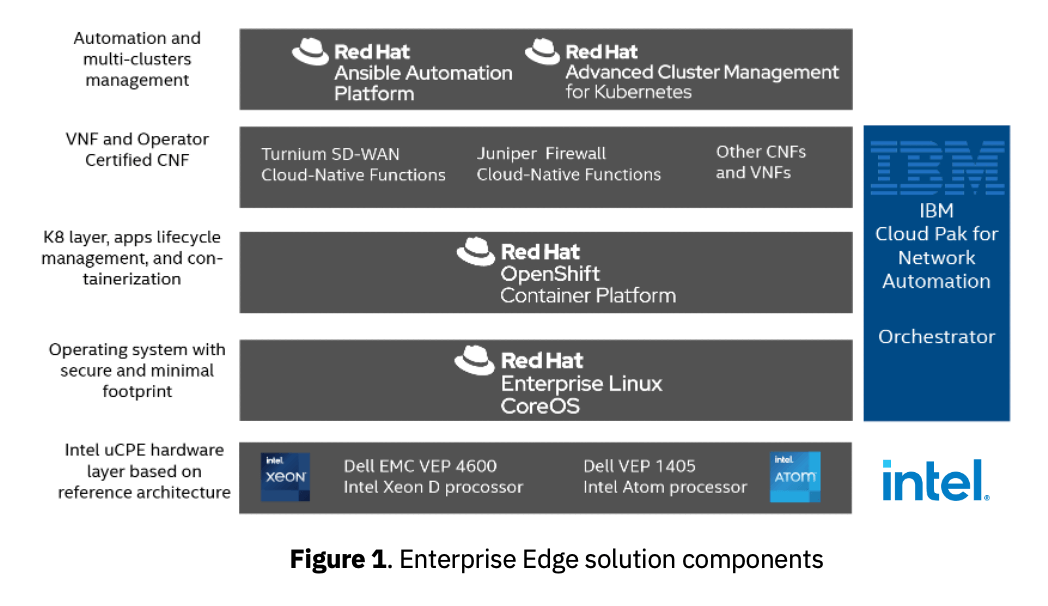The following post has been adapted from the original LinkedIn post by IBM’s Bill Lambertson, Vice President, Cloud, 5G, and Edge
The vision of delivering commercial-grade, cloud-native CPE-based edge services for enterprises has been realized with a landmark solution release. Co-engineered by a multi-partner team — a technology collaboration forged by IBM, Intel, Red Hat, Juniper, and Turnium — this open standards Enterprise Edge solution operating on IBM Cloud for Telecommunication supports cloud-native container network functions (CNFs) and virtual network functions (VNFs).
Hosted on Red Hat OpenShift and coordinated by IBM Cloud Pak for Network Automation, the new solution operates on Intel architecture hardware. To complete the network services platform, Turnium delivers a layer 3 network overlay solution and a SD-WAN deployable as a managed service or as an OEM white-label software platform. Juniper provides CNFs for firewall, routing, and other services are supported by Red Hat OpenShift.
The following image offers a simplified view of the solution components including Dell EMC Virtual Edge Platform.

Challenges Facing Enterprises Today
An increasing number of enterprises are recognizing that consolidating computing workloads provides many benefits, particularly when integrating cloud-native services into their infrastructure. The top business value of distributed cloud services include:
- Gaining easy access to cloud-based services
- Improving business agility cost-effectively by converging OT, CT, and IT
- Unifying cloud operations in a secure, visible manner, employing the latest uCPE technologies for communicating among branch offices and the hybrid cloud
- Lowering latency and increasing the availability of cloud-based solutions at the network edge
Resolving Business Challenges at the Edge
The Enterprise Edge solution addresses these challenges:
- Access: Tested and validated hardware and software components to streamline the deployment of cloud-native infrastructure on-premises. Turnium SD-WAN seamlessly connects enterprises communicating with branch offices anywhere in the world in a manageable, secure, easy-to-deploy framework. Red Hat OpenShift provides the Kubernetes-based environment, allocating compute, networking, storage resources, and balancing workloads, so enterprise customers get flexible, extensible access to cloud-based services. IBM Cloud Satellite extends IBM Cloud services to any environment, including the Enterprise Edge.
- Agility: Red Hat OpenShift application platform represents a leading cloud-native solution for handling virtualized and containerized uCPE processes. OpenShift lets customers quickly deploy applications and microservices on-premises in branch offices and apply automation, advanced provisioning features guided by AI, and software lifecycle management to support business practices and policies. IBM Cloud Pak for Network Automation provides enterprises with AI-driven automated network operations and allows them to rapidly develop and deploy new services at the edge. IBM Cloud Satellite provides a consistent set of services to improve development velocity across public cloud and edge infrastructures.
- Reduced personnel training needs: The Enterprise Edge solution dramatically reduces the need for specialized, trained personnel to perform maintenance, updates, and configuration tasks. The solution’s centralized control model provides policy-driven automation and can be combined with AI tools to intelligently manage many network-edge processes. IBM Cloud Satellite is an IBM SRE-managed cloud solution that brings IBM Cloud services to any environment — on-premises, in any public cloud, or at the edge.
- Lower CapEx and OpEx: Red Hat OpenShift makes it possible to run diverse applications across a shared kernel, supporting the consolidation of CT, OT, and IT operations on a single server. Using containers enables a much smaller footprint and lower energy use than full-function VMs. Development and management of VMs can be complex. Each VM by design contains a separate operating system and has a storage footprint that typically ranges to several gigabytes. Portability of applications across hybrid clouds or edge computing installations is very limited. In comparison, containers have excellent portability across on-premises and cloud environments, providing a smaller footprint, typically in the megabyte range, simpler management than VMs, a built-in method for more efficient software updates and patches, and faster application startup times. IBM Cloud Satellite Infrastructure Service provides on-premises dedicated cloud Infrastructure as a Service (IaaS) with monthly consumption OpEx and flexible sizing with no long-term infrastructure commitments. These factors can contribute to lower CapEx and OpEx values for the enterprise.
- Reliance on standards-based components: The Enterprise Edge solution is built with open-source components, making it easier to design, develop, and deploy a complete solution, minimizing interoperability issues, and offering numerous add-ons and enhancements through edge computing and IoT ecosystem. Architecture support for Intel® Smart Edge Open (formally known as OpenNESS) gives developers a royalty-free multi-access edge computing (MEC) software toolkit for enhancing service capabilities and optimizing performance for a wide variety of enterprise use cases. Red Hat OpenShift extends the flexibility and interoperability of an open, standards-based infrastructure to a wide range of cloud-native workloads, providing automation and advanced management capabilities to simplify operating at the edge.
- High-availability and security: The Enterprise Edge solution features cloud-native network security functions from Juniper together with the cloud-native SD-WAN from Turnium, delivering strong security and ensuring high-availability for external connectivity.

The primary hardware/software reference architecture developed by Intel, IBM, and Red Hat is enhanced and extended with integrations of Dell, Juniper, and Turnium technologies.
The Juniper cSRX Firewall is a container-based, integrated network function, providing application security, intrusion protection, automated life cycle controls, and unified policy management. The cSRX equips security professionals with the tools to deploy and scale firewall and advanced threat detection and prevention in dynamic container environments.
The Turnium cloud-native SD-WAN solution is a certified CNF for Red Hat OpenShift, delivering secure, reliable, and flexible connectivity for uCPE implementations at the network edge. By aggregating or bonding wireless and wireline connectivity, the solution links branch offices, cloud locations, and the main office, using a comprehensive RESTful API to integrate with existing Operations Support / Business Support Systems (OSS/BSS). Turnkey, managed SD-WAN services are offered, as well as an OEM SD-WAN solution that CSPs or ISPs can license to deliver services to their customers.
The Dell EMC Virtual Edge Platform (VEP) delivers flexibility at the Edge, enabling organizations to pivot from monolithic legacy equipment to a modern Open Networking platform engineered to power the next generation of virtual networking. VEP accelerates network edge transformation, makes it secure and straightforward, allowing organizations to rapidly modernize networking and IT at the Edge. SD-WAN, load balancers, and firewalls are just some of the virtual network functions that can be implemented using VEP 4600 and VEP 1405.
Conclusion
This new Enterprise Edge solution establishes a standards-based framework for bringing cloud-native CPE edge services to enterprises. The solution provides the equivalent of a cloud for network services that can operate on-premises, depending on the application. Enterprise customers with widespread branch locations, service providers, and others stand to gain a reliable, cost-effective means for deploying network functions with the lightweight portability of Red Hat OpenShift and the orchestration software provided by IBM. Juniper and Turnium combine cloud-native services for business agility and security. The Intel architecture-based infrastructure can provide the level of processing needed for diverse applications at the edge, from compact, energy-efficient Intel Atom processors to the Intel Xeon D processor family for heavy workloads to the high-performance Intel Scalable processor family for AI and analytics available on Dell EMC Virtual Edge Platform.

1 thought on “How Cloud-Native Technology is Helping to Reimagine the Enterprise Edge”
Comments are closed.